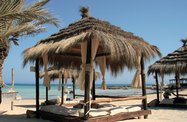Tunisia: A different approach
 En Français
En Français
A new government tourism management agency set to begin operations this month will bring together several aspects of Tunisia’s tourism sector under one roof, combining efforts to increase promotion, develop overall strategy and facilitate a more liberalised air transport policy, including overseeing negotiations for an open skies agreement.
The new unit, which is in the process of being established under the Ministry of Tourism, will have to oversee a changing sector. In the past, Tunisia has relied heavily on its seaside resorts to attract package tourists, primarily from France, Italy, Germany and the UK. In fact, 80% of visitors come from six countries, Elyès Fakhfakh, the minister of tourism, told international media recently.
However, the emphasis on package tourism has resulted in relatively modest visitor spending, particularly when compared to other regional destinations such as Egypt and Morocco, limiting sector revenues. This was exacerbated when tourist arrivals dropped some 2.5m visitors to 4.5m in 2011 after former President Zine Al Abidine Ben Ali was ousted in a popular uprising. The unrest in neighbouring Libya, previously a major market for Tunisia’s hospitality industry, further compounded the sector’s woes, while the eurozone debt crisis has moderated demand.
Speaking to news agency Reuters in April, Fakhfakh said he believed numbers would recover in 2012 although would fall short of the level of 7m arrivals seen in 2010. The latest figures from the research department at the Ministry of Tourism show that receipts from the sector are starting to recover, having dropped from TD1.78bn (€892.8m) in 2010 to TD1.11bn (€554.8m) in 2011. As of July 31, tourism receipts have climbed back to TD1.53bn (€765m).
Tourism arrivals are beginning to improve as well, with 3.24m tourists entering the country through the end of July, a 34% increase on the 2.42m arrivals in the first six months of 2011, but still down on the 3.97m total tourists who arrived between January 1 and July 31, 2010.
Tourism remains big business in the country, with the travel and tourism sector directly accounting for 6.6% of GDP in 2011, a figure that is forecast to rise to 8% this year, according to the World Travel & Tourism Council (WTTC). The sector’s direct and indirect contribution accounted for at least 14.3% of GDP in 2011, according to the WTTC. The sector is also a major employer, employing 415,500 people in 2011, or 12.9% of total employment.
To maintain this expected level of growth, however, both the private and public sector will need to further diversify the country’s overall appeal, both in terms of markets and in terms of activities. Niche tourism activities, such as health and eco-tourism, offer extensive room for growth, particularly at the high end of the market where thalassotherapy resorts have already had an impact. Similarly, non-traditional markets such as Russia and China, who hitherto have not comprised a particularly large proportion of Tunisia’s inbound holidaymakers, have sent burgeoning numbers of tourists to other Mediterranean markets such as Egypt and Turkey, highlighting the potential for Tunisia to increase its own slice of the pie.
The previous government had taken a number of steps in this regard, spending roughly €28m annually on advertising campaigns, while new classification systems for hotel facilities were introduced, in a bid to encourage an improvement in accommodation standards.
According to Fakhfakh, the country’s current aim is to diversify its existing tourism product to include desert adventure holidays, spas, golf and a greater focus on the country’s diverse regions, including deserts, forests and archaeological Roman and Islamic sites.
Tunisia held its first Alternative Tourism Fair in 2012 in June in the village of Ken near Bouficha, in the Sousse governorate. Habib Ammar, the director-general of the Tunisian National Tourism Office (L’Office National du Tourisme Tunisien), speaking to Agence France Presse in Tunis, said that the fair was an initiative undertaken by the newly formed Association for the Promotion of Alternative Tourism in Tunisia (L’Association de Promotion du Tourisme Alternatif en Tunisie, APTAT). The main aim of alternative tourism is to reduce Tunisia’s reliance on seasonal visitors by providing a diversified tourism sector that will receive visitors year round.
The minister of tourism is also working with other North African states to encourage long-haul visitors from Asia and the US to book multi-stop packages, such as Roman tours across Tunisia and North Africa.
Negotiations with the EU over an open skies agreement is also hoped to put the sector on a more secure footing for the future. Open skies is supposed to make it easier for foreign and low-cost airlines to use the country’s airports. Morocco’s decision to sign a similar agreement in 2006 led to an increase in low-cost flights to cities such as Marrakesh – although some carriers have struggled with the increased competition – and Tunisia is hoping a similar open skies agreement will provide the same increase in traffic.
According to Fakhfakh, negotiations are expected to take between six months and one year to conclude. Once agreed, the new tourism management unit at the Ministry of Tourism will have responsibility for its implementation.
The limits of package and budget tourism – the traditional mainstays of Tunisian tourism – have long been clear to those working in the sector, and for a number of years, private operators have been pushing to improve the attractiveness of the country for high-end and niche visitors, with some success. However, the drop in visitors and the subdued interest from major markets has lent new urgency to the government’s push to diversify Tunisia’s appeal.



